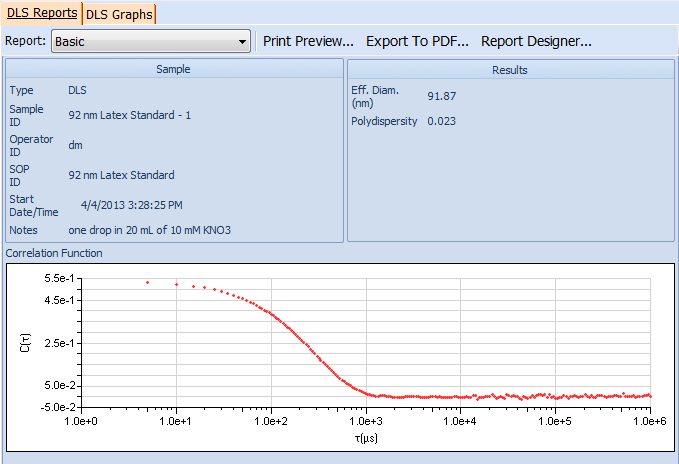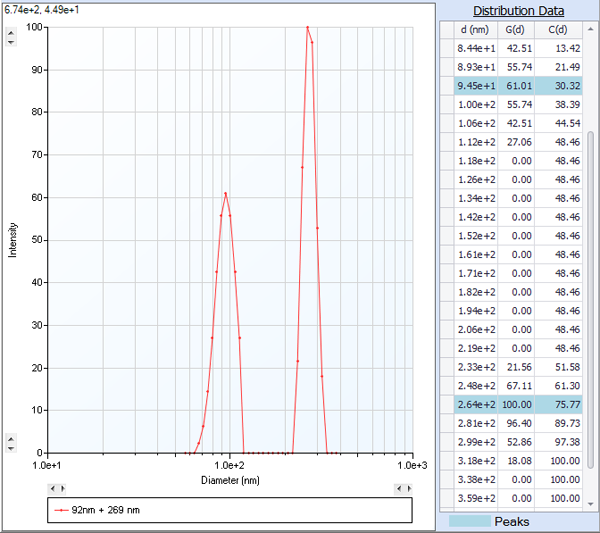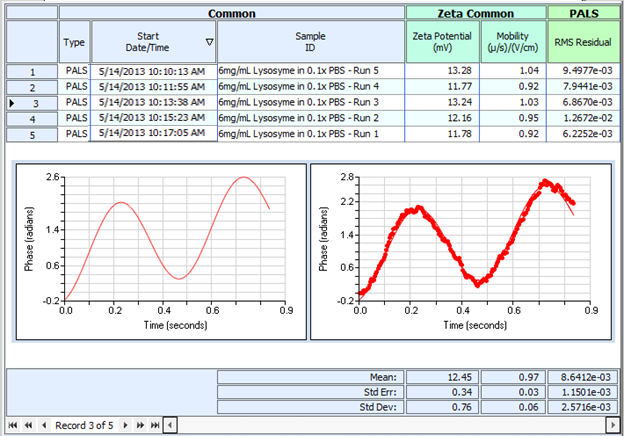
Features at a glance
SIZING
- Rapid and accurate particle size distributions
- Multimodal & unimodal size distribution software
- ISO 13321 and ISO 22412 compliant results
- Range > 1 nm to 6 µm
- Customizable reports
- Ideal for fast, routine sizing applications in research or quality control
- High power 35 mW diode laser
- Dynamic light scattering at 90°
- Temperature control, -5 °C to 110 °C
- Compact bench top unit, USB connection
ZETA POTENTIAL
- Zeta potential for the difficult cases
- For proteins, peptides, mAb, RNA, and other biological samples
- For zeta potential in organic solvents
- For oily or viscous media
- For high-salt suspensions
- For samples near the I.E.P.
- 1,000 times more sensitive than other techniques
- Disposable cuvettes, no contamination or alignment
- Built in automatic procedures and parameters (SOP)
- Easy to use
Brookhaven's NanoBrook 90Plus PALS instrument combines our NanoBrook 90Plus and NanoBrook ZetaPALS instruments in to one powerful package for sizing and zeta potential analysis. With over a decade of proven records in diverse applications, Brookhaven's pioneer Phase Analysis Light Scattering (PALS) technology remains a step ahead of the competition. This package delivers unparalleled zeta potential (surface charge) measurement sensitivity and accuracy. It also provides unique real-time (in-situ) monitoring capability for electrophoretic response of particles/molecules under an electric field, a valuable tool ONLY from Brookhaven for delicate biological entities like proteins and exosomes. It has been successfully utilized in nearly every possible suspension environment from high salts such as PBS and sea water to organic solvents and of course aqueous solutions.
Reliable, Accurate, and Easy to Use
The new NanoBrook 90Plus PALS particle size and zeta potential analyzer incorporates all you need for fast, routine, sub-micron measurements of size and zeta potential. Based on the principles of Dynamic Light Scattering (DLS) for particle sizing and distribution, and based on phase analysis light scattering for zeta potential measurements; most measurements only take a minute or two.
Two Scattering Angles:
Particle sizing measurements will be made at the 90° scattering angle. Zeta potential measurements are always done using the 15° detection angle to minimize diffusion broadening.
Principles of Operation - Particle Sizing using DLS
Dilute suspensions, on the order of 0.0001 to 1.0% v/v are prepared, using suitable wetting and/or dispersing agents. A small ultrasonicator is sometimes useful in breaking up loosely-held agglomerates. Two or three mL of suspension are required to make the measurements. Disposable, polystyrene square cells are used for aqueous and simple alcohol suspensions. Disposable, glass round cells with reusable Teflon stoppers are used for aggressive solvent suspensions. Just a few minutes are required for the sample and cell to equilibrate with the actively controlled temperature environment inside the NanoBrook 90Plus PALS. A square glass cell is available if desired and special small-volume cells may be used to reduce the volume of material needed to just 50 µL or 10 µL. For aqueous samples the 50 µL is a disposable cuvette. In all cases the sample is recoverable. For very small particles the high-sensitivity BI-APD detector is invaluable.
Reproducibility

| Instrument |
Nom. 90 |
Nom. 273 |
Nom. 111 |
Nom. 400 |
| A |
91±1 |
276±1 |
110±1 |
404±4 |
| B |
90±1 |
279±1 |
108±1 |
391±3 |
| C |
90±1 |
276±1 |
109±1 |
399±3 |
| D |
90±1 |
277±1 |
110±1 |
397±3 |
| E |
- |
- |
112±1 |
394±3 |
| Ave. |
90.3 |
277.0 |
109.8 |
397.0 |
| Std. Err |
±0.3% |
±0.3% |
±0.6% |
±0.6% |
| Test Results from Brookhaven Instruments Particle Size Analyzers(diameters, in nm) |
Test Results from Brookhaven Instruments Particle Size Analyzers(diameters, in nm)
Perhaps the most important benefit for users is the reproducibility from sample-to-sample, operator-to-operator, and instrument-to-instrument. The table to the right shows the results obtained for polystyrene latex. Notice the Std. Error of the Effective (or Average) Diameter is less than 1% of the mean of the 10 repeated runs. Such excellent repeatability is typical of the NanoBrook 90Plus particle size analyzer for QC analysis and ensures product quality time-after-time. The table also shows several aspects of the inter-instrument repeatibility found with routine Brookhaven dynamic light scattering equipment. To test the reliability of the information obtained with Brookhaven Instruments a customer subjected five instruments in five locationswith different operators and using four different samples for examination. The table above shows excellent reproducibility with recognized standard materials and superb internal agreement. You can be confident of the results you get with your NanoBrook 90Plus!
Data Presentation
The NanoBrook 90Plus PALS particle size and zeta potential analyzer offers three choices. For routine determinations an average diameter (Eff. Dia.) and a measure of the distribution width (Polydispersity) are sufficient for many applications. The second choice is to fit these values to a lognormal distribution, allowing the user to visualize the size distribution and to interpolate cumulative and differential results at 5% intervals.

Results from Test Bimodal Sample on NanoBrook 90Plus PALS (diameters, in nm)
The figure above shows an example of the third choice, suitable for more complicated, multimodal size distributions. Here, a numerical algorithm, including Mie theory, is used. These results are for a mixture of known latex particles. Positions of the measured particle sizes on the accompanying graph are in excellent agreement with the known sizes of 92 and 269 nm.
During a measurement, the display can be switched interactively between any one of these -- correlation function, lognormal, or multimodal -- each shown "live" as data are accumulated. The live display is particularly useful in determining the end-point of a measurement where multimodal distribution shape may be important
Principles of Operation - Phase Analysis Light Scattering (PALS)
For measurements of very low mobilities, the NanoBrook 90Plus PALS is the answer. The only answer! With concepts developed at Bristol University and Brookhaven Instruments, the NanoBrook 90Plus PALS determines zeta potential using Phase Analysis Light Scattering: A technique that is up to 1,000 times more sensitive than traditional light scattering methods based on the shifted frequency spectrum.
Electrostatic repulsion of colloidal particles is often the key to understanding the stability of any dispersion. A simple, easy measurement of the electrophoretic mobility "even in nonpolar liquids" yields valuable information. Measurements made in water and other polar liquids are easy and fast with the NanoBrook ZetaPlus. Such measurements cover the range of typically ± (6 to 100) mV, corresponding to mobilities of ± 10-11 to 10-7 m2/V·s. The NanoBrook 90Plus PALS covers this full range, of course, and extends it by a factor of 1000 in sensitivity!
The NanoBrook 90Plus PALS utilizes phase analysis light scattering to determine the electrophoretic mobility of charged, colloidal suspensions. Unlike its cousin, Laser Doppler Velocimetry (LDV) (sometimes called Laser Doppler Electrophoresis (LDE)), the PALS technique does not require the application of large fields which may result in thermal problems or denaturation. This is due to the fact that the measurement analyzes the phase shift. The particles need only to move a fraction of their own diameter to yield good results. In salt concentrations up to 2 molar and with electric fields as small as 1 or 2 V/cm enough movement is induced to get excellent results. In addition, the Autotracking feature compensates for thermal drift.

Figure 1
Simple Clear Presentation
Figure 1 above shows the results of an actual experiment with a NanoBrook 90Plus PALS instrument. The important parameters and results are seen at a glance. The excellent agreement of the five runs in this experiment is obvious as is the match of expermental curve (red, bold) and it's fitted version (red, thin). As with all Brookhaven instruments the user can simply produce a customized report.
Multiple Sample Types
Table 1 below shows a variety of difficult to measure samples, all of which were easily measured with the NanoBrook 90Plus PALS. Some were measured in high salt concentration; some in low dielectric constant non-polar solvents; and one in a viscous liquid.
Electrophoretic Mobilities Determined with the NanoBrook 90Plus PALS
(units 10-8 m2 /V·s) |
| Sample |
PALS Result |
Lit. Value |
Comments |
| NIST 1980 |
2.51 ± 0.11 |
2.53 ± 0.12 |
Electrophoretic mobility standard. |
| Blood Cells |
-1.081 ± 0.015 |
-1.08 ± 0.02 |
Dispersed in physiological saline |
| Fe2O3 |
0.013 ± 0.0015 |
N.A. |
Dispersed in dodecane |
| TiO2 |
0.255 ± 0.010 |
N.A. |
Dispersed in toluene - not dried |
| TiO2 |
0.155 ± 0.011 |
N.A. |
Dispersed in toluene - dried |
| TiO2 |
-0.503 ± 0.015 |
N.A. |
Dispersed in ethanol |
| Casein |
-0.025 ± 0.002 |
N.A. |
Dispersed in PEG - viscous |
| SiO2 |
-0.73 ± 0.04 |
N.A. |
Dispersed in 2.0 M KCl - High salt |
Custom Columns
The software can be easily customized to display the columns needed for a quick review of the important parameters as shown below

Figure 2
Something More Challenging
Of course the NanoBrook 90Plus PALS can quickly and easily yield results from all "regular" samples but its real strength is in the difficult cases and to demonstrate the performance of this premium instrument where others fail, we offer the following table:
Biological samples such as proteins, antibodies, peptides, DNA/RNA are easily denatured by electrical fields. The NanoBrook 90Plus PALS can successfully measure the mobility of biological samples with typical voltages from 2 to 4 Volts. In Figure 1 above, Lysozyme was measured with 2.5 Volts applied.
Aggressive Solventssuch as DMF, THF, DMSO, MET, etc. are easily accomodated by Brookhaven's NanoBrook 90Plus PALS system with the use of our special solvent resistant electrodes and glass sample cells. The extension of zeta potential measurements into the realm of such systems is just another standout property of the NanoBrook 90Plus PALS. Some examples of this are shown in Table 1.
High salt concentrations difficult to measure due to the Joule heating and energy dissipated. The power applied in high salt has to be kept low in order to avoid affecting the sample. Only Brookhaven's NanoBrook 90Plus PALS can measure in salt conditions up to 2 Molar. An example is shown in Table 1.
Unusual solvent? If your solvent is unusual then it's dielectric constant is probably unknown. In thise case our BI-870 Dielectric Constant Meter will quickly, easily, and accurately provide the information necessary for a zeta potential determination.


 (028) 22 611 711
(028) 22 611 711
 Danh mục
Danh mục
 High Purity Northwest Inc.
High Purity Northwest Inc.
 Phóng Điện Cục Bộ
Phóng Điện Cục Bộ





































 Gọi điện
Gọi điện SMS
SMS Chỉ Đường
Chỉ Đường